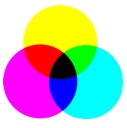Why do so many keep dpi and ppi the same? When is it dpi and when is it ppi? And above all: what is the difference?
PPI
PPI (pixels per inch) are clearly defined color points (pixels) in a fixed grid. Depending on the product (sensor / light source), each individual pixel can assume color values from 1 bit (2 colors) to 48 bits (280 trillion colors).
- Fixed size per pixel
- Area-filling color per pixel
- Any color value 1 - 48 bit
Use of the term ppi: all devices that can display many colors per pixel:
- Digital cameras
- Scanner
- Monitors / screens
- Projector
- Display
![]() Any color values as pixels.
Any color values as pixels.
![]() Here a gray bar (gray pixels) recorded with a digital camera.
Here a gray bar (gray pixels) recorded with a digital camera.
It is therefore not possible to display every ppi with one dpi.
DPI
DPI (dots per inch) are limited color dots, mostly from printers. The color points are therefore directly dependent on the number of color sources of the devices used. A simple inkjet printer delivers 4-6 colors (known as ink cartridges). However, in contrast to the PPI, the color points can change in size and thereby influence the color character in terms of color intensity.
- Different dot size
- Reduced number of basic colors per point (e.g. 4 -6 colors for printers)
- The PPI pixel colors must be generated by several DPI points
- A 1200 dpi printer with a 6x6 matrix can only display one 200 PPI pixel
Use: Mostly only printers that have to get by with a few basic colors per point:
- Laser printer
- Inkjet printer
![]() Here a 4-color printer CMY + Black.
Here a 4-color printer CMY + Black.
![]() The colors can only be represented by mixing the basic colors and the size of the dots.
The colors can only be represented by mixing the basic colors and the size of the dots.
Here is the same gray bar as in the example above, but printed. In the 6x6 dot matrix, the different black dots produce a gray when viewed from a distance.
![]() A gray bar printed.
A gray bar printed.
The mixture of the basic colors C (cyan) M (mangenta) Y (yellow) and K for key (black component)
 The CMYK color model.
The CMYK color model.